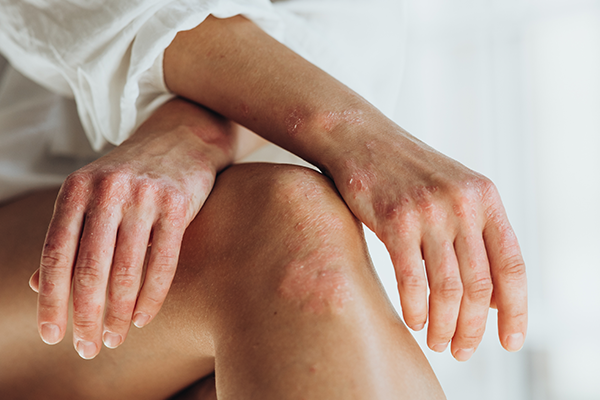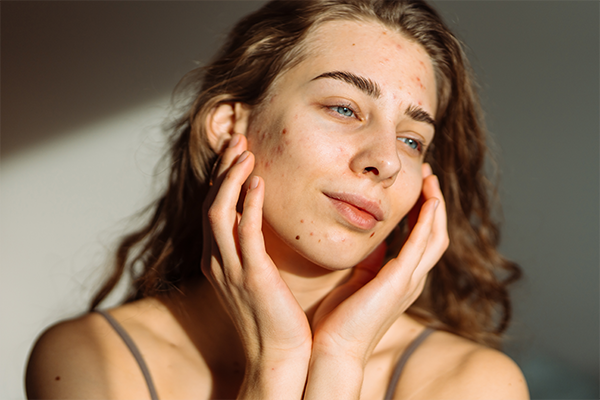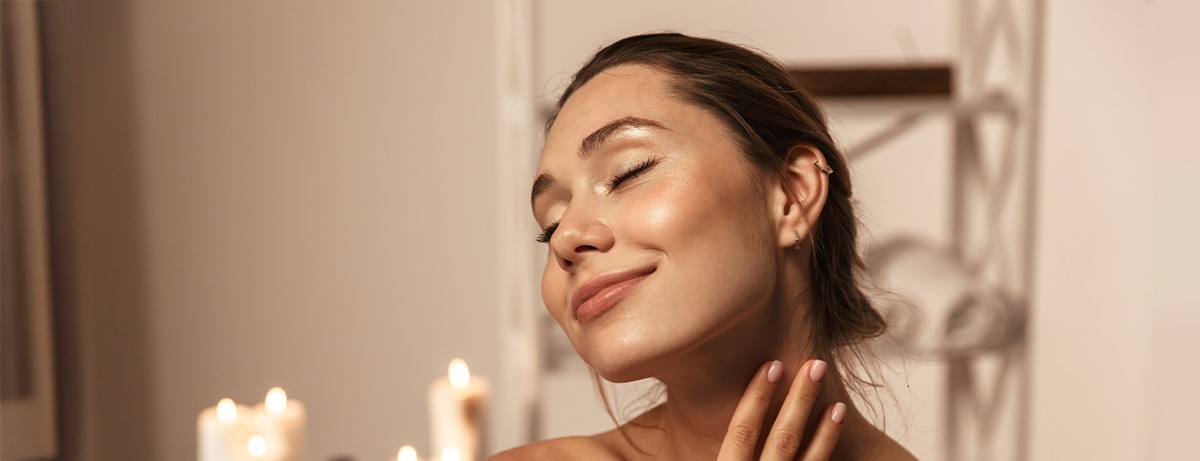15% off £25 or 20% off £35
Code:BASKET
Common skin conditions: what you need to know

Skin acting up? From eczema flare-ups and stubborn blackheads to everyday irritation, we’ve got expert tips and practical fixes to help you feel like yourself again
Summary
1Hives
Hives, also known as urticaria, are your skin’s way of waving a big red flag and saying, "Something’s not right here..."
2Contact dermatitis
Contact dermatitis is a type of eczema that develops when your skin reacts to a substance it doesn’t like, resulting in redness...
3Psoriasis
Psoriasis is more than just dry skin – it’s an autoimmune condition that speeds up skin cell production, causing thick, scaly patches…
Skin: one moment it’s flawless, the next it’s flaring up with bumps, blotches or breakouts. But don’t stress – most skin struggles are easier to tackle than they seem. (That said, if you experience persistent or worsening symptoms, contact a healthcare professional for advice).
If you’re having one of those moments, don’t fret – we’ll explore common skin conditions and uncover tips to keep your skin fresh, clear and comfortable…
What are some common skin conditions?
Hives
Hives, also known as urticaria, are your skin’s way of waving a big red flag and saying, ‘Something’s not right here!’.
These raised, itchy bumps, often red or skin-coloured, can appear suddenly, turning your skin into an unintentional dot-to-dot masterpiece, and can vanish just as quickly.1,2
Hives are one of your immune system’s reactions to triggers such as certain foods, medications, insect bites or environmental factors like pollen.2 They can emerge anywhere on your body, ranging from tiny spots to larger, merged patches.1 While they’re usually short-lived, chronic hives that linger may need specialised attention from a healthcare professional.2
When hives strike, an antihistamine is your first line of defence – think of it as a bouncer stepping in to calm the commotion and kick out the culprit behind the itch.2
For immediate relief, cool your skin with a cold compress and stick to loose, breathable clothing to minimise irritation.2,3 Want to outsmart future hives? Keep a ‘hive diary’ to track potential triggers and avoid them in the future.
Eczema
Eczema, often described as atopic dermatitis, is a condition that can leave your skin feeling itchy, inflamed and sometimes cracked or dry.4 While it often begins in childhood, eczema can affect anyone at any age and often runs in families.4
Triggers vary widely from person to person, ranging from allergens and irritants to weather changes – or even those extra stressful days when everything feels a bit much.5,6
Keeping your skin happy starts with hydration. Slather an emollient-rich moisturiser on your skin immediately after a lukewarm bath or shower to lock in moisture.7,8 Go easy on your skin by skipping the hot water (tempting, but not helpful) and using gentle, fragrance-free cleansers to keep irritation at bay.8
If flare-ups get feisty, over-the-counter hydrocortisone creams can offer relief, and your doctor can prescribe stronger solutions if necessary.9 Finally, create a skin-friendly zone by keeping your space clean, reducing dust and choosing comfy, breathable fabrics such as cotton.10

Psoriasis
Psoriasis is more than just dry skin – it’s an autoimmune condition that speeds up skin cell production, causing thick, scaly patches.11 These often appear on the scalp, elbows, knees or lower back.11
Triggers, such as stress, infections or environmental factors, can send psoriasis into overdrive, making flare-ups a bit of a guessing game.12
Managing psoriasis often takes a team effort. Creams and ointments, such as vitamin D analogues and topical corticosteroids, can help slow skin cell growth and reduce scaling and itching.13,14
For more stubborn cases, phototherapy (UV light) may help ease symptoms, while systemic medications might be necessary for severe cases. Check with your doctor if you’ve got psoriasis and it’s bothering you, especially before trying any treatment or medication.13
Rosacea
Rosacea is a chronic skin condition that primarily affects the face.15 It often starts with your face tending to flush or blush easily but can progress into more persistent redness, visible blood vessels and acne-like bumps.15,16
While the exact cause is still a bit of a mystery, certain triggers – like alcohol, spicy foods, extreme temperatures or too much sun – are thought to intensify symptoms.15,17
Begin with a gentle skincare routine, using non-abrasive cleansers and soothing moisturisers.18
If redness and bumps persist, prescription creams or oral antibiotics may help reduce inflammation.16 Avoiding known triggers, such as alcohol or UV light (don’t forget your daily SPF), can make a considerable difference.16 And for those extra rosy days, a dab of green-tinted makeup can neutralise the redness and give your confidence a little lift.19
Keratosis pilaris
Keratosis pilaris is a harmless but stubborn condition that leaves small, rough bumps on your upper arms, thighs or cheeks.20 It results from keratin building up and clogging your hair follicles.21
While keratosis pilaris often improves over time, a little extra care can help smooth things out.21
Gently exfoliate with a loofah or a mild chemical exfoliator containing ingredients like lactic acid, glycolic acid or salicylic acid.21,22 Then lock in hydration with a rich moisturiser – look for one with urea or lactic acid and apply within five minutes of bathing for the best results.21,22
Contact dermatitis
Contact dermatitis is a type of eczema that develops when your skin reacts to a substance it doesn’t like, resulting in redness, itching and sometimes blistering.23
There are two main types: irritant contact dermatitis, caused by direct damage to the skin, and allergic contact dermatitis, triggered by an immune response.23 Common culprits? Think detergents, jewellery, latex and some beauty products.23
The first step in managing contact dermatitis is identifying the irritant or allergen and steering clear of it.23
Emollient creams can help moisturise and hydrate your skin, while antihistamines are great for taming the itch.23 If the reaction is severe, a doctor may recommend oral corticosteroids to help things settle down.24
Warts
Warts are small, rough growths that can appear on your hands, feet or face.25 They’re caused by certain strains of the human papillomavirus (HPV), making them highly contagious – they can spread through skin-to-skin contact or by sharing surfaces.25,26
While harmless, warts can be uncomfortable or a bit of a confidence-killer, depending on their location.27
Over-the-counter treatments such as salicylic acid or freezing sprays can help gradually shrink warts over time. For warts that won’t budge, a doctor may use freezing treatments (cryotherapy) or refer you to a dermatologist, particularly if the wart is in a sensitive area, such as the face.28
Cellulite
Let’s talk about cellulite – the dimples most of us have on our thighs and hips. It’s completely natural, affecting up to 90% of women (and some men too), and gets its trademark ‘orange peel’ appearance from complex interactions between fat, connective tissue and skin structure.29
Simple fixes for cellulite, like caffeine-based creams, may give your skin a temporary pick-me-up, while massages boost circulation and leave you feeling fabulous.29
Regular exercise and a balanced diet can also help keep things firm and toned. For something more advanced, professional treatments target deeper layers of skin to even things out.29
Blackheads
Blackheads are like little party crashers on your skin. They’re a form of mild acne caused by clogged hair follicles. And that dark colour? It’s not dirt, but a result of a reaction between oil and air (oxidation, if you want to sound fancy).30 They tend to hang out in oily areas such as your nose, chin, forehead and even your ears.30
Keep blackheads in check with a gentle cleanser and exfoliate using products with salicylic acid to clear clogged pores.30 Clay masks can also work wonders by soaking up excess oil.31
A professional chemical peel or extraction could help with stubborn blackheads, or you could try removing them yourself with nose strips.32,33 And whatever you do, resist the urge to squeeze them at home – it can lead to scarring and make things worse.30

Acne
Acne is one of the most common skin conditions, affecting up to 80% of people at some point in their lives.34 It’s caused by a combination of factors, including excess oil production, clogged pores, bacteria and hormonal changes.30 Acne can range from the occasional pimple to severe cystic acne.35
Managing acne can take time, with results often becoming noticeable after a few months.36 For mild breakouts, over-the-counter creams with benzoyl peroxide can be effective.
If your acne doesn’t improve, a doctor may recommend stronger treatments like topical retinoids, antibiotics or (for women) hormonal therapies like the combined pill. A dermatologist may suggest advanced treatments such as isotretinoin for severe acne or scarring.36
The final say
Your skin’s as unique as you are, and caring for it doesn’t have to feel overwhelming. By understanding the causes of common skin conditions, you can take steps towards healthier, happier skin.
If your symptoms aren’t improving or seem to be getting worse, speak to a doctor for advice and extra support.
Ready to upgrade your skincare basics? Check out our favourite daily moisturisers with SPF.
Disclaimer - This article provides informational advice and is not a substitute for medical care. Curated by experts for accuracy, we take great care to ensure the information is up-to-date and relevant. However, you should always consult your GP or healthcare professional before using supplements or alternative products, particularly if you have medical conditions or are under supervision.
1. Kanani A, et al. Urticaria and angioedema. Allergy Asthma Clin Immunol. 2018;14(S2):59. https://doi.org/10.1186/s13223-018-0288-z
2. Kayiran MA. Diagnosis and treatment of urticaria in primary care. North Clin Istanb. 2019;6(1):93–9. https://doi.org/10.14744/nci.2018.75010
3. Liu B, Jordt SE. Cooling the itch via TRPM8. J Invest Dermatol. 2018;138(6):1254–6. https://doi.org/10.1016/j.jid.2018.01.020
4. National Institute of Arthritis and Musculoskeletal and Skin Diseases. Atopic dermatitis [Internet]. [cited 2024 Nov 26]. Available from: https://www.niams.nih.gov/health-topics/atopic-dermatitis
5. Luschkova D, et al. Atopic eczema is an environmental disease. Allergol Select. 2021;5(1):244–50. https://doi.org/10.5414/alx02258e
6. Lönndahl L, et al. Psychological stress and atopic dermatitis: A focus group study. Ann Dermatol. 2023;35(5):342–7. https://doi.org/10.5021/ad.22.035
7. Hon KL, et al. Emollient treatment of atopic dermatitis: Latest evidence and clinical considerations. Drugs Context. 2018;7:212530. https://doi.org/10.7573/dic.212530
8. National Institute of Allergy and Infectious Diseases. Eczema (atopic dermatitis) treatment [Internet]. [cited 2024 Nov 26]. Available from: https://www.niaid.nih.gov/diseases-conditions/eczema-treatment
9. Institute for Quality and Efficiency in Health Care. Eczema: Learn more — steroids and other topical medications [Internet]. [cited 2024 Nov 26]. Available from: https://www.ncbi.nlm.nih.gov/books/NBK424899/
10. Kolb L, Ferrer-Bruker SJ. Atopic dermatitis. Treasure Island (FL): StatPearls Publishing; 2023. Available from: https://www.ncbi.nlm.nih.gov/books/NBK448071/
11. Badri T, et al. Plaque psoriasis. Treasure Island (FL): StatPearls Publishing; 2023. Available from: https://www.ncbi.nlm.nih.gov/books/NBK430879/
12. Liu S, et al. Triggers for the onset and recurrence of psoriasis: A review and update. Cell Commun Signal. 2024;22(1):108. https://doi.org/10.1186/s12964-023-01381-0
13. Raharja A, et al. Psoriasis: A brief overview. Clin Med (Lond). 2021;21(3):170–3. https://doi.org/10.7861/clinmed.2021-0257
14. American Academy of Dermatology Association. Psoriasis treatment: Synthetic vitamin D [Internet]. [cited 2024 Nov 26]. Available from: https://www.aad.org/public/diseases/psoriasis/treatment/medications/synthetic-d
15. Farshchian M, Daveluy S. Rosacea. Treasure Island (FL): StatPearls Publishing; 2023. Available from: https://www.ncbi.nlm.nih.gov/books/NBK557574/
16. National Institute of Arthritis and Musculoskeletal and Skin Diseases. Rosacea [Internet]. [cited 2024 Nov 26]. Available from: https://www.niams.nih.gov/health-topics/rosacea
17. Weiss E, Katta R. Diet and rosacea: The role of dietary change in the management of rosacea. Dermatol Pract Concept. 2017;7(4):31–7. https://doi.org/10.5826/dpc.0704a08
18. Zhang H, et al. Rosacea treatment: Review and update. Dermatol Ther (Heidelb). 2020;11(1):13–24. https://doi.org/10.1007/s13555-020-00461-0
19. National Rosacea Society. Makeup for rosacea [Internet]. [cited 2024 Nov 26]. Available from: https://www.rosacea.org/patients/makeup-for-rosacea
20. Drivenes JL, et al. Keratosis pilaris. Tidsskr Nor Laegeforen. 2023;143(5).https://doi.org/10.4045/tidsskr.22.0513
21. Pennycook KB, McCready TA. Keratosis pilaris. Treasure Island (FL): StatPearls Publishing; 2023. Available from: https://www.ncbi.nlm.nih.gov/books/NBK546708/
22. American Academy of Dermatology Association. Keratosis pilaris: Diagnosis and treatment [Internet]. [cited 2024 Nov 26]. Available from: https://www.aad.org/public/diseases/a-z/keratosis-pilaris-treatment
23. Litchman G, et al. Contact dermatitis. Treasure Island (FL): StatPearls Publishing; 2023. Available from: https://www.ncbi.nlm.nih.gov/books/NBK459230/
24. American Academy of Dermatology Association. Eczema types: Contact dermatitis diagnosis and treatment [Internet]. [cited 2024 Nov 26]. Available from: https://www.aad.org/public/diseases/eczema/types/contact-dermatitis/treatment
25. Luria L, Cardoza-Favarato G. Human papillomavirus. Treasure Island (FL): StatPearls Publishing; 2023. Available from: https://www.ncbi.nlm.nih.gov/books/NBK448132/
26. Institute for Quality and Efficiency in Health Care. Warts: Overview [Internet]. [cited 2024 Nov 26]. Available from: https://www.ncbi.nlm.nih.gov/books/NBK279586/
27. Ciconte A, et al. Warts are not merely blemishes on the skin: A study on the morbidity associated with having viral cutaneous warts. Australas J Dermatol. 2003;44(3):169–73. https://doi.org/10.1046/j.1440-0960.2003.00672.x
28. National Institute for Health and Care Excellence. Warts and verrucae: Scenario: Management [Internet]. [cited 2024 Nov 26]. Available from: https://cks.nice.org.uk/topics/warts-verrucae/management/management/
29. Gabriel A, et al. Cellulite: Current understanding and treatment. Aesthet Surg J Open Forum. 2023;5:ojad050. https://doi.org/10.1093/asjof/ojad050
30. Sutaria AH, Schlessinger J. Acne vulgaris. Treasure Island (FL): StatPearls Publishing; 2023. Available from: https://www.ncbi.nlm.nih.gov/books/NBK459173/
31. Zhang X, et al. Comprehensive assessment of the efficacy and safety of a clay mask in oily and acne skin. Skin Res Technol. 2023;29(11):e13513. https://doi.org/10.1111/srt.13513
32. Chen X, et al. Chemical peels for acne vulgaris: A systematic review of randomised controlled trials. BMJ Open. 2018;8(4):e019607. https://doi.org/10.1136/bmjopen-2017-019607
33. Bernadette I, et al. Acne lesion extraction versus oral doxycycline for moderate acne vulgaris: A randomized clinical trial. J Clin Aesthet Dermatol. 2021;14(6):E61–5. https://pmc.ncbi.nlm.nih.gov/articles/PMC8594536/
34. Szepietowska M, et al. Prevalence, intensity and psychosocial burden of acne itch: Two different cohorts study. J Clin Med. 2023;12(12):3997. https://doi.org/10.3390/jcm12123997
35. National Institute of Arthritis and Musculoskeletal and Skin Diseases. Acne [Internet]. [cited 2024 Nov 26]. Available from: https://www.niams.nih.gov/health-topics/acne
36. NHS. Acne: Treatment [Internet]. [cited 2024 Nov 26]. Available from: https://www.nhs.uk/conditions/acne/treatment/












